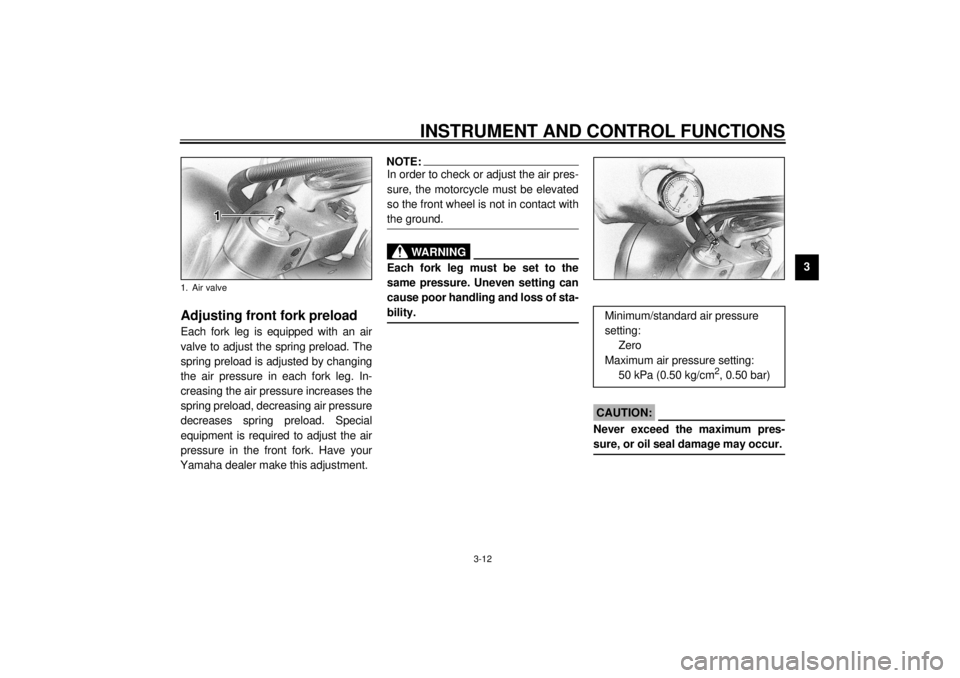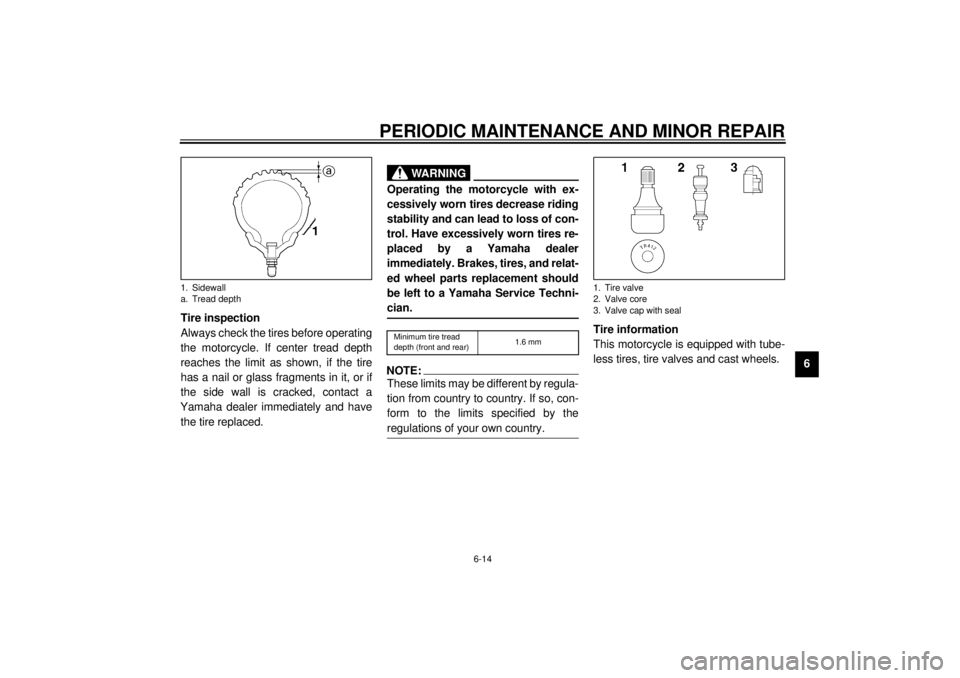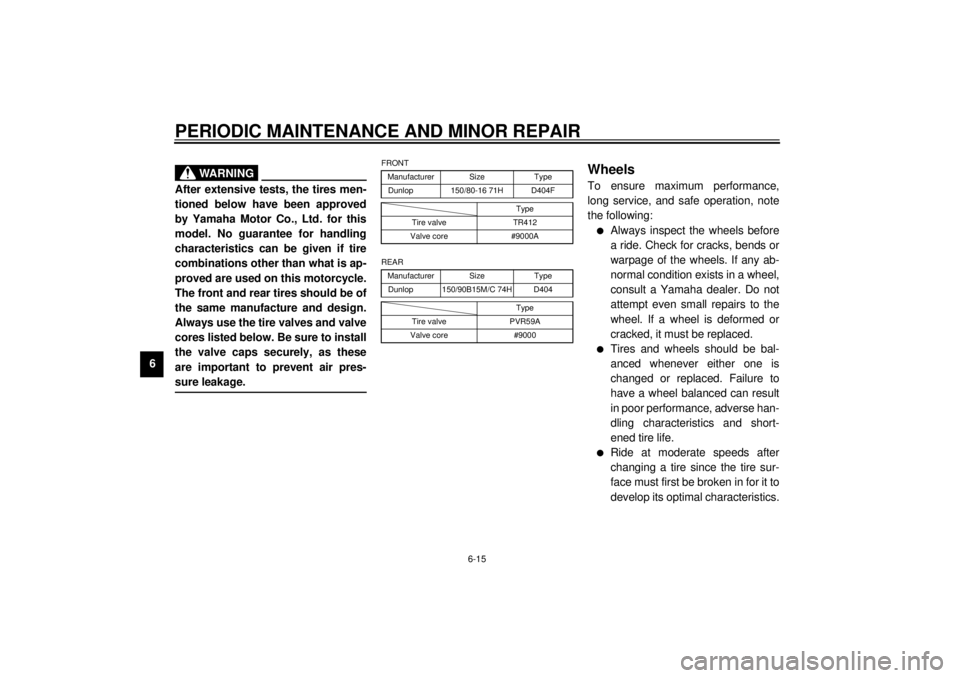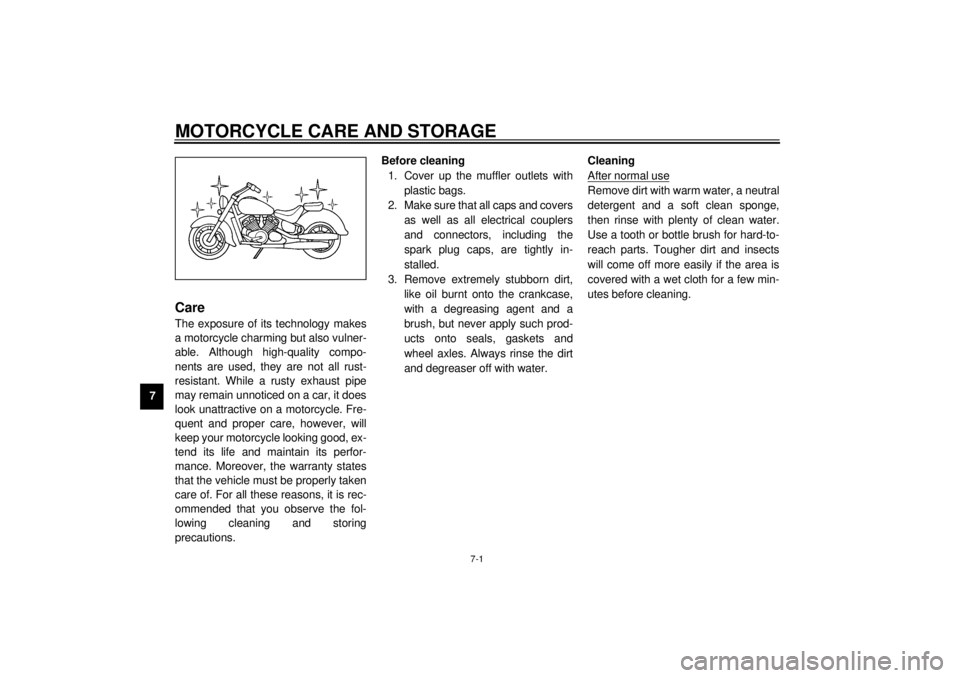2000 YAMAHA XVZ1300A wheel
[x] Cancel search: wheelPage 26 of 91

INSTRUMENT AND CONTROL FUNCTIONS
3-12
3
EAU01605
Adjusting front fork preloadEach fork leg is equipped with an air
valve to adjust the spring preload. The
spring preload is adjusted by changing
the air pressure in each fork leg. In-
creasing the air pressure increases the
spring preload, decreasing air pressure
decreases spring preload. Special
equipment is required to adjust the air
pressure in the front fork. Have your
Yamaha dealer make this adjustment.
NOTE:@ In order to check or adjust the air pres-
sure, the motorcycle must be elevated
so the front wheel is not in contact with
the ground. @
EW000037
WARNING
@ Each fork leg must be set to the
same pressure. Uneven setting can
cause poor handling and loss of sta-
bility. @
EC000012
CAUTION:@ Never exceed the maximum pres-
sure, or oil seal damage may occur. @
1. Air valve
Minimum/standard air pressure
setting:
Zero
Maximum air pressure setting:
50 kPa (0.50 kg/cm
2, 0.50 bar)
E_4YP_Functions.fm Page 12 Wednesday, October 6, 1999 10:03 AM
Page 31 of 91

4-1
4
EAU01114
4-PRE-OPERATION CHECKSOwners are personally responsible for their vehicle’s condition. Your motorcycle’s vital functions can start to deteriorate
quickly and unexpectedly, even if it remains unused (for instance, if it is exposed to the elements). Any damage, fluid leak or
loss of tire pressure could have serious consequences. Therefore, it is very important that, in addition to a thorough visual in-
spection, you check the following points before each ride.
EAU00340
PRE-OPERATION CHECK LIST
ITEM CHECKS PAGE
Front brake• Check operation, fluid level and vehicle for fluid leakage.
• Fill with DOT 4 brake fluid if necessary.
6-17 ~ 6-21
Rear brake• Check operation, fluid level and vehicle for fluid leakage.
• Fill with DOT 4 brake fluid if necessary.
Clutch• Check operation, fluid level and vehicle for fluid leakage.
• Fill with DOT 4 brake fluid if necessary.6-16
Throttle grip and housing• Check for smooth operation.
• Lubricate if necessary.6-12
Engine oil• Check oil level.
• Fill with oil if necessary.6-7 ~ 6-9
Coolant reservoir tank• Check coolant level.
• Fill with coolant if necessary.6-10 ~ 6-11
Final gear oil• Check vehicle for leakage. 6-10
Wheels and tires• Check tire pressure, wear and for damage. 6-13 ~ 6-16
Brake and shift pedal
shafts• Check for smooth operation.
• Lubricate if necessary.6-21
Brake and clutch lever
pivots• Check for smooth operation.
• Lubricate if necessary.6-22
Sidestand pivot• Check for smooth operation.
• Lubricate if necessary.6-22
E_4YP_Preop.fm Page 1 Wednesday, October 6, 1999 10:04 AM
Page 42 of 91

6
PERIODIC MAINTENANCE AND MINOR REPAIR
Tool kit................................................................... 6-1
Periodic maintenance and lubrication ................... 6-3
Spark plugs........................................................... 6-6
Engine oil .............................................................. 6-7
Final gear oil ....................................................... 6-10
Coolant ............................................................... 6-10
Carburetor adjustment ........................................ 6-11
Idle speed adjustment ........................................ 6-11
Throttle cable free play inspection ...................... 6-12
Valve clearance adjustment ................................ 6-12
Tires .................................................................... 6-13
Wheels ................................................................ 6-15
Clutch lever free play adjustment........................ 6-16
Front brake lever free play adjustment ................ 6-17
Rear brake pedal height adjustment ................... 6-17Brake light switch adjustment ............................. 6-18
Checking the front and rear brake pads ............. 6-19
Inspecting the brake fluid level ........................... 6-19
Brake fluid replacement ..................................... 6-21
Brake and shift pedal lubrication ........................ 6-21
Brake and clutch lever lubrication ...................... 6-22
Sidestand lubrication.......................................... 6-22
Front fork inspection ........................................... 6-23
Battery................................................................ 6-23
Fuse replacement .............................................. 6-25
Headlight bulb replacement ............................... 6-27
Turn signal and taillight bulb replacement .......... 6-28
Troubleshooting .................................................. 6-28
Troubleshooting chart ......................................... 6-29
E_4YP_PeriodicTOC.fm Page 1 Wednesday, October 6, 1999 10:05 AM
Page 45 of 91

PERIODIC MAINTENANCE AND MINOR REPAIR
6-3
6
EAU00473
PERIODIC MAINTENANCE AND LUBRICATION
CP-01ENO. ITEM CHECKS AND MAINTENANCE JOBSINITIAL
(1,000 km)EVERY
6,000 km
or
6 months
(whichever
comes first)12,000 km
or
12 months
(whichever
comes first)
1
*Fuel line• Check fuel hoses for cracks or damage.
• Replace if necessary.ÖÖ
2*Fuel filter• Check condition.
• Replace if necessary.Ö
3 Spark plugs• Check condition.
• Clean, regap or replace if necessary.ÖÖÖ
4*Valves• Check valve clearance.
• Adjust if necessary.Every 42,000 km or 42 months
(whichever comes first)
5 Air filter• Clean or replace if necessary.ÖÖ
6*Clutch• Check operation, fluid level and vehicle for fluid leakage.
(See NOTE on page 6-5.)
• Correct accordingly. ÖÖÖ
7*Front brake• Check operation, fluid level and vehicle for fluid leakage.
(See NOTE on page 6-5.)
• Correct accordingly.
• Replace brake pads if necessary.ÖÖÖ
8*Rear brake• Check operation, fluid level and vehicle for fluid leakage.
(See NOTE on page 6-5.)
• Correct accordingly.
• Replace brake pads if necessary.ÖÖÖ
9*Wheels• Check balance, runout and for damage.
• Rebalance or replace if necessary.ÖÖ
* Since these items require special tools, data and technical skills, they should be serviced by a Yamaha dealer.
E_4YP_Periodic.fm Page 3 Wednesday, October 6, 1999 10:05 AM
Page 46 of 91

PERIODIC MAINTENANCE AND MINOR REPAIR
6-4
6
10
*Tires• Check tread depth and for damage.
• Replace if necessary.
• Check air pressure.
• Correct if necessary.ÖÖ
11*Wheel bearings• Check bearing for looseness or damage.
• Replace if necessary. ÖÖ
12*Swingarm• Check swingarm pivoting point for play.
• Correct if necessary.
• Lubricate with molybdenum disulfide grease every 24,000 km or
24 months (whichever comes first).ÖÖ
13*Steering bearings• Check bearing play and steering for roughness.
• Correct accordingly.
• Lubricate with lithium soap base grease every 24,000 km
or 24 months (whichever comes first).ÖÖ
14*Chassis fasteners• Make sure that all nuts, bolts and screws are properly tightened.
• Tighten if necessary.ÖÖ
15 Sidestand• Check operation.
• Lubricate and repair if necessary.ÖÖ
16*Sidestand switch• Check operation.
• Replace if necessary.ÖÖÖ
17*Front fork• Check operation and for oil leakage.
• Correct accordingly.ÖÖ
18*Rear shock absorber
assembly• Check operation and shock absorber for oil leakage.
• Replace shock absorber assembly if necessary. ÖÖ
19*Rear suspension relay
arm and connecting arm
pivoting points• Check operation.
• Lubricate with molybdenum disulfide grease every 24,000 km or
24 months (whichever comes first).ÖÖ NO. ITEM CHECKS AND MAINTENANCE JOBSINITIAL
(1,000 km)EVERY
6,000 km
or
6 months
(whichever
comes first)12,000 km
or
12 months
(whichever
comes first)
* Since these items require special tools, data and technical skills, they should be serviced by a Yamaha dealer.
E_4YP_Periodic.fm Page 4 Wednesday, October 6, 1999 10:05 AM
Page 56 of 91

PERIODIC MAINTENANCE AND MINOR REPAIR
6-14
6 Tire inspection
Always check the tires before operating
the motorcycle. If center tread depth
reaches the limit as shown, if the tire
has a nail or glass fragments in it, or if
the side wall is cracked, contact a
Yamaha dealer immediately and have
the tire replaced.
EW000079
WARNING
@ Operating the motorcycle with ex-
cessively worn tires decrease riding
stability and can lead to loss of con-
trol. Have excessively worn tires re-
placed by a Yamaha dealer
immediately. Brakes, tires, and relat-
ed wheel parts replacement should
be left to a Yamaha Service Techni-
cian. @CE-11ENOTE:@ These limits may be different by regula-
tion from country to country. If so, con-
form to the limits specified by the
regulations of your own country. @
Tire information
This motorcycle is equipped with tube-
less tires, tire valves and cast wheels.
1. Sidewall
a. Tread depth
Minimum tire tread
depth (front and rear)1.6 mm
1. Tire valve
2. Valve core
3. Valve cap with seal
E_4YP_Periodic.fm Page 14 Wednesday, October 6, 1999 10:05 AM
Page 57 of 91

PERIODIC MAINTENANCE AND MINOR REPAIR
6-15
6
EW000132
WARNING
@ After extensive tests, the tires men-
tioned below have been approved
by Yamaha Motor Co., Ltd. for this
model. No guarantee for handling
characteristics can be given if tire
combinations other than what is ap-
proved are used on this motorcycle.
The front and rear tires should be of
the same manufacture and design.
Always use the tire valves and valve
cores listed below. Be sure to install
the valve caps securely, as these
are important to prevent air pres-
sure leakage. @
CE-41E
CE-42EEAU01230
WheelsTo ensure maximum performance,
long service, and safe operation, note
the following:l
Always inspect the wheels before
a ride. Check for cracks, bends or
warpage of the wheels. If any ab-
normal condition exists in a wheel,
consult a Yamaha dealer. Do not
attempt even small repairs to the
wheel. If a wheel is deformed or
cracked, it must be replaced.
l
Tires and wheels should be bal-
anced whenever either one is
changed or replaced. Failure to
have a wheel balanced can result
in poor performance, adverse han-
dling characteristics and short-
ened tire life.
l
Ride at moderate speeds after
changing a tire since the tire sur-
face must first be broken in for it to
develop its optimal characteristics.
FRONT
Manufacturer Size Type
Dunlop 150/80-16 71H D404F
Type
Tire valve TR412
Valve core #9000A
REAR
Manufacturer Size Type
Dunlop 150/90B15M/C 74H D404
Type
Tire valve PVR59A
Valve core #9000
E_4YP_Periodic.fm Page 15 Wednesday, October 6, 1999 10:05 AM
Page 75 of 91

7-1
7
EAU01521
7-MOTORCYCLE CARE AND STORAGECareThe exposure of its technology makes
a motorcycle charming but also vulner-
able. Although high-quality compo-
nents are used, they are not all rust-
resistant. While a rusty exhaust pipe
may remain unnoticed on a car, it does
look unattractive on a motorcycle. Fre-
quent and proper care, however, will
keep your motorcycle looking good, ex-
tend its life and maintain its perfor-
mance. Moreover, the warranty states
that the vehicle must be properly taken
care of. For all these reasons, it is rec-
ommended that you observe the fol-
lowing cleaning and storing
precautions.Before cleaning
1. Cover up the muffler outlets with
plastic bags.
2. Make sure that all caps and covers
as well as all electrical couplers
and connectors, including the
spark plug caps, are tightly in-
stalled.
3. Remove extremely stubborn dirt,
like oil burnt onto the crankcase,
with a degreasing agent and a
brush, but never apply such prod-
ucts onto seals, gaskets and
wheel axles. Always rinse the dirt
and degreaser off with water.Cleaning
After normal use
Remove dirt with warm water, a neutral
detergent and a soft clean sponge,
then rinse with plenty of clean water.
Use a tooth or bottle brush for hard-to-
reach parts. Tougher dirt and insects
will come off more easily if the area is
covered with a wet cloth for a few min-
utes before cleaning.
E_4YP_Cleaning.fm Page 1 Wednesday, October 6, 1999 10:06 AM